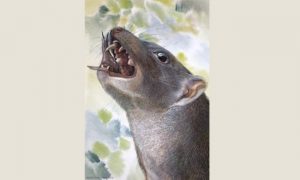
An international team of palaeontologists which includes Dr Robin Beck of the University of Salford, have identified an entirely new family of extinct marsupial mammals from northern Australia.
No other mammal currently known has such an unusual crushing premolar, but similar teeth are seen in Australian lizards that feed on snails, suggesting that malleodectids may have had a similar diet. Malleodectids, which were about the size of ferret, are known only from 10-15 million year old fossils from the Riversleigh World Heritage Area in far northern Australia.
Very incomplete malleodectid fossils were described in 2011, but the discovery of a new fossil jawbone has now revealed unique features indicating a previously unknown marsupial family.
The research is published today in the Scientific Reports arm of the journal Nature.
Malleodectids were probably related to living Australian carnivorous marsupials such as quolls, the Tasmanian Devil and the marsupial anteater or numbat, as well as the recently extinct thylacine or Tasmanian tiger. However, malleodectids represent a lineage of marsupials that has been distinct since at least 23 million years ago.
Dr Beck, an expert in evolutionary biology at the School of Environment and Life Sciences, who analysed the fossils, said: “Discovering an entirely new family of marsupials is really remarkable – the discovery of such a weird animal just goes to show that we have much, much more to find about the evolution of mammals.”
Dr Beck added: “Without the CT data, it would have been very difficult to identify this specimen – new technology is really helping us to get the maximum amount of information out of fossil finds.”
The team, which is led by Mike Archer and Sue Hand at the University of New South Wales, will return to Riversleigh in July in the hope of finding more remains of malleodectids, as well as other fossil animals known from the site.
The paper – A new family of bizarre durophagous carnivorous marsupials from Miocene deposits in the Riversleigh World Heritage Area, northwestern Queensland M. Archer1, S. J. Hand1, K. H. Black1, R. M. D. Beck1,2, D. A. Arena1, L. A. B. Wilson1, S. Kealy3 & T.-t. Hung4 – will be published in Scientific Reports on the 27th of May 2016 and is freely available online at www.nature.com/articles/srep26911
1 – PANGEA Research Centre, School of Biological, Earth & Environmental Sciences, University of New South Wales, NSW 2052, Australia. 2 – School of Environmental & Life Sciences, University of Salford, Salford M5 4WT, UK. 3 – Department of Archaeology and Natural History, School of Culture, History and Language, College of Asia and the Pacific, Australian National University, ACT 2601, Australia. 4 – Biological Resources Imaging Laboratory, Mark Wainwright Analytical Centre, University of New South Wales 2052, Australia. Correspondence and requests for materials should be addressed to M.A. (email: m.archer@unsw.edu.au)